Mesopotamia
| History of Iraq |
|---|
 |
|
|
Mesopotamia[a] is a historical region of West Asia situated within the Tigris–Euphrates river system, in the northern part of the Fertile Crescent. Today, Mesopotamia is known as present-day Iraq.[1][2] In the broader sense, the historical region of Mesopotamia also includes parts of present-day Iran, Turkey, Syria and Kuwait.[3][4]
Mesopotamia is the site of the earliest developments of the Neolithic Revolution from around 10,000 BC. It has been identified as having "inspired some of the most important developments in human history, including the invention of the wheel, the planting of the first cereal crops, the development of cursive script, mathematics, astronomy, and agriculture". It is recognised as the cradle of some of the world's earliest civilizations.[5]
The Sumerians and Akkadians, each originating from different areas, dominated Mesopotamia from the beginning of recorded history (c. 3100 BC) to the fall of Babylon in 539 BC. The rise of empires, beginning with Sargon of Akkad around 2350 BC, characterized the subsequent 2,000 years of Mesopotamian history, marked by the succession of kingdoms and empires such as the Akkadian Empire. The early second millennium BC saw the polarization of Mesopotamian society into Assyria in the north and Babylonia in the south. From 900 to 612 BC, the Neo-Assyrian Empire asserted control over much of the ancient Near East. Subsequently, the Babylonians, who had long been overshadowed by Assyria, seized power, dominating the region for a century as the final independent Mesopotamian realm until the modern era.[6] In 539 BC, Mesopotamia was conquered by the Achaemenid Empire. The area was next conquered by Alexander the Great in 332 BC. After his death, it became part of the Greek Seleucid Empire.
Around 150 BC, Mesopotamia was under the control of the Parthian Empire. It became a battleground between the Romans and Parthians, with western parts of the region coming under ephemeral Roman control. In 226 AD, the eastern regions of Mesopotamia fell to the Sassanid Persians. The division of the region between the Roman Byzantine Empire from 395 AD and the Sassanid Empire lasted until the 7th century Muslim conquest of Persia of the Sasanian Empire and the Muslim conquest of the Levant from the Byzantines. A number of primarily neo-Assyrian and Christian native Mesopotamian states existed between the 1st century BC and 3rd century AD, including Adiabene, Osroene, and Hatra.
Etymology
The regional toponym Mesopotamia (/ˌmɛsəpəˈteɪmiə/, Ancient Greek: Μεσοποταμία '[land] between rivers'; Arabic: بِلَاد ٱلرَّافِدَيْن Bilād ar-Rāfidayn or بَيْن ٱلنَّهْرَيْن Bayn an-Nahrayn; Syriac: ܒܝܬ ܢܗܪ̈ܝܢ Beth Nahrain "(land) between the (two) rivers") comes from the ancient Greek root words μέσος (mesos, 'middle') and ποταμός (potamos, 'river')[7] and translates to '(land) between rivers', likely being a calque of the older Aramaic term, with the Aramaic term itself likely being a calque of the Akkadian birit narim. It is used throughout the Greek Septuagint (c. 250 BC) to translate the Hebrew and Aramaic equivalent Naharaim. An even earlier Greek usage of the name Mesopotamia is evident from The Anabasis of Alexander, which was written in the late 2nd century AD but specifically refers to sources from the time of Alexander the Great. In the Anabasis, Mesopotamia was used to designate the land east of the Euphrates in north Syria.
The Akkadian term biritum/birit narim corresponded to a similar geographical concept.[8] Later, the term Mesopotamia was more generally applied to all the lands between the Euphrates and the Tigris, thereby incorporating not only parts of Syria but also almost all of Iraq and southeastern Turkey.[9] The neighbouring steppes to the west of the Euphrates and the western part of the Zagros Mountains are also often included under the wider term Mesopotamia.[10][11][12]
A further distinction is usually made between Northern or Upper Mesopotamia and Southern or Lower Mesopotamia.[2] Upper Mesopotamia, also known as the Jazira, is the area between the Euphrates and the Tigris from their sources down to Baghdad.[10] Lower Mesopotamia is the area from Baghdad to the Persian Gulf and includes Kuwait and parts of western Iran.[2]
In modern academic usage, the term Mesopotamia often also has a chronological connotation. It is usually used to designate the area until the Muslim conquests, with names like Syria, Jazira, and Iraq being used to describe the region after that date.[9][13] It has been argued that these later euphemisms[clarification needed] are Eurocentric terms attributed to the region in the midst of various 19th-century Western encroachments.[13][14]
Geography
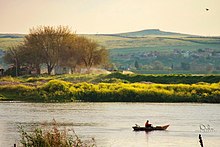

Mesopotamia encompasses the land between the Euphrates and Tigris rivers, both of which have their headwaters in the neighboring Armenian highlands. Both rivers are fed by numerous tributaries, and the entire river system drains a vast mountainous region. Overland routes in Mesopotamia usually follow the Euphrates because the banks of the Tigris are frequently steep and difficult. The climate of the region is semi-arid with a vast desert expanse in the north which gives way to a 15,000-square-kilometre (5,800 sq mi) region of marshes, lagoons, mudflats, and reed banks in the south. In the extreme south, the Euphrates and the Tigris unite and empty into the Persian Gulf.
The arid environment ranges from the northern areas of rain-fed agriculture to the south where irrigation of agriculture is essential.[16] This irrigation is aided by a high water table and by melting snows from the high peaks of the northern Zagros Mountains and from the Armenian Highlands, the source of the Tigris and Euphrates Rivers that give the region its name. The usefulness of irrigation depends upon the ability to mobilize sufficient labor for the construction and maintenance of canals, and this, from the earliest period, has assisted the development of urban settlements and centralized systems of political authority.
Agriculture throughout the region has been supplemented by nomadic pastoralism, where tent-dwelling nomads herded sheep and goats (and later camels) from the river pastures in the dry summer months, out into seasonal grazing lands on the desert fringe in the wet winter season. The area is generally lacking in building stone, precious metals, and timber, and so historically has relied upon long-distance trade of agricultural products to secure these items from outlying areas.[17] In the marshlands to the south of the area, a complex water-borne fishing culture has existed since prehistoric times and has added to the cultural mix.
Periodic breakdowns in the cultural system have occurred for a number of reasons. The demands for labor has from time to time led to population increases that push the limits of the ecological carrying capacity, and should a period of climatic instability ensue, collapsing central government and declining populations can occur. Alternatively, military vulnerability to invasion from marginal hill tribes or nomadic pastoralists has led to periods of trade collapse and neglect of irrigation systems. Equally, centripetal tendencies amongst city-states have meant that central authority over the whole region, when imposed, has tended to be ephemeral, and localism has fragmented power into tribal or smaller regional units.[18] These trends have continued to the present day in Iraq.
History
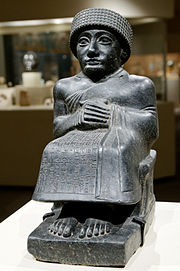
The prehistory of the Ancient Near East begins in the Lower Paleolithic period. Therein, writing emerged with a pictographic script, Proto-cuneiform, in the Uruk IV period (c. late 4th millennium BC). The documented record of actual historical events—and the ancient history of lower Mesopotamia—commenced in the early-third millennium BC with cuneiform records of early dynastic kings. This entire history ends with either the arrival of the Achaemenid Empire in the late 6th century BC or with the Muslim conquest and the establishment of the Caliphate in the late 7th century AD, from which point the region came to be known as Iraq. In the long span of this period, Mesopotamia housed some of the world's most ancient highly developed, and socially complex states.
The region was one of the four riverine civilizations where writing was invented, along with the Nile valley in Ancient Egypt, the Indus Valley civilization in the Indian subcontinent, and the Yellow River in Ancient China. Mesopotamia housed historically important cities such as Uruk, Nippur, Nineveh, Assur and Babylon, as well as major territorial states such as the city of Eridu, the Akkadian kingdoms, the Third Dynasty of Ur, and the various Assyrian empires. Some of the important historical Mesopotamian leaders were Ur-Nammu (king of Ur), Sargon of Akkad (who established the Akkadian Empire), Hammurabi (who established the Old Babylonian state), Ashur-uballit I and Tiglath-Pileser I (who established the Assyrian Empire).
Scientists analysed DNA from the 8,000-year-old remains of early farmers found at an ancient graveyard in Germany. They compared the genetic signatures to those of modern populations and found similarities with the DNA of people living in today's Turkey and Iraq.[19]
Periodization


- Pre- and protohistory
- Pre-Pottery Neolithic A (10,000–8700 BC)
- Pre-Pottery Neolithic B (8700–6800 BC)
- Jarmo (7500–5000 BC)
- Hassuna (~6000 BC)
- Samarra (~5700–4900 BC)
- Halaf cultures (~6000–5300 BC)
- Ubaid period (~6500–4000 BC)
- Uruk period (~4000–3100 BC)
- Jemdet Nasr period (~3100–2900 BC)[20]
- Early Bronze Age
- Early Dynastic period (~2900–2350 BC)
- Akkadian Empire (~2350–2100 BC)
- Third Dynasty of Ur (2112–2004 BC)
- Middle Bronze Age
- Isin-Larsa period (19th to 18th century BC)
- First Babylonian dynasty (18th to 17th century BC)
- Minoan eruption (c. 1620 BC)
- Late Bronze Age
- Old Assyrian period (16th to 11th century BC)
- Middle Assyrian period (c. 1365–1076 BC)
- Kassites in Babylon, (c. 1595–1155 BC)
- Late Bronze Age collapse (12th to 11th century BC)
- Iron Age
- Syro-Hittite states (11th to 7th century BC)
- Neo-Assyrian Empire (10th to 7th century BC)
- Neo-Babylonian Empire (7th to 6th century BC)
- Classical antiquity
- Fall of Babylon (6th century BC)
- Achaemenid Babylonia, Achaemenid Assyria (6th to 4th century BC)
- Seleucid Mesopotamia (4th to 3rd century BC)
- Parthian Babylonia (3rd century BC to 3rd century AD)
- Osroene (2nd century BC to 3rd century AD)
- Adiabene (1st to 2nd century AD)
- Hatra (1st to 2nd century AD)
- Roman Mesopotamia (2nd to 7th century AD), Roman Assyria (2nd century AD)
- Late Antiquity
- Asōristān (3rd to 7th century AD)
- Muslim conquest (mid-7th century AD)
Language and writing
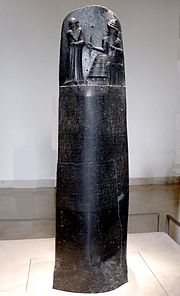
The earliest language written in Mesopotamia was Sumerian, an agglutinative language isolate. Along with Sumerian, Semitic languages were also spoken in early Mesopotamia.[21] Subartuan,[22] a language of the Zagros possibly related to the Hurro-Urartuan language family, is attested in personal names, rivers and mountains and in various crafts. Akkadian came to be the dominant language during the Akkadian Empire and the Assyrian empires, but Sumerian was retained for administrative, religious, literary and scientific purposes.
Different varieties of Akkadian were used until the end of the Neo-Babylonian period. Old Aramaic, which had already become common in Mesopotamia, then became the official provincial administration language of first the Neo-Assyrian Empire, and then the Achaemenid Empire: the official lect is called Imperial Aramaic. Akkadian fell into disuse, but both it and Sumerian were still used in temples for some centuries. The last Akkadian texts date from the late 1st century AD.
Early in Mesopotamia's history, around the mid-4th millennium BC, cuneiform was invented for the Sumerian language. Cuneiform literally means "wedge-shaped", due to the triangular tip of the stylus used for impressing signs on wet clay. The standardized form of each cuneiform sign appears to have been developed from pictograms. The earliest texts, 7 archaic tablets, come from the É, a temple dedicated to the goddess Inanna at Uruk, from a building labeled as Temple C by its excavators.
The early logographic system of cuneiform script took many years to master. Thus, only a limited number of individuals were hired as scribes to be trained in its use. It was not until the widespread use of a syllabic script was adopted under Sargon's rule[23] that significant portions of the Mesopotamian population became literate. Massive archives of texts were recovered from the archaeological contexts of Old Babylonian scribal schools, through which literacy was disseminated.
Akkadian gradually replaced Sumerian as the spoken language of Mesopotamia somewhere around the turn of the 3rd and the 2nd millennium BC. The exact dating being a matter of debate.[24] Sumerian continued to be used as a sacred, ceremonial, literary, and scientific language in Mesopotamia until the 1st century AD.
Literature
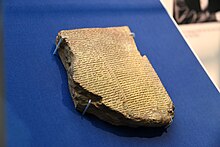
Libraries were extant in towns and temples during the Babylonian Empire. An old Sumerian proverb averred that "he who would excel in the school of the scribes must rise with the dawn." Women as well as men learned to read and write,[25] and for the Semitic Babylonians, this involved knowledge of the extinct Sumerian language, and a complicated and extensive syllabary.
A considerable amount of Babylonian literature was translated from Sumerian originals, and the language of religion and law long continued to be the old agglutinative language of Sumer. Vocabularies, grammars, and interlinear translations were compiled for the use of students, as well as commentaries on the older texts and explanations of obscure words and phrases. The characters of the syllabary were all arranged and named, and elaborate lists were drawn up.
Many Babylonian literary works are still studied today. One of the most famous of these was the Epic of Gilgamesh, in twelve books, translated from the original Sumerian by a certain Sîn-lēqi-unninni, and arranged upon an astronomical principle. Each division contains the story of a single adventure in the career of Gilgamesh. The whole story is a composite product, although it is probable that some of the stories are artificially attached to the central figure.
Science and technology
Mathematics
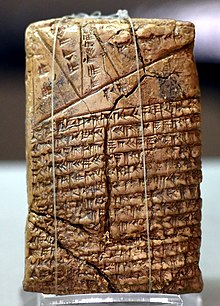
Mesopotamian mathematics and science was based on a sexagesimal (base 60) numeral system. This is the source of the 60-minute hour, the 24-hour day, and the 360-degree circle. The Sumerian calendar was lunisolar, with three seven-day weeks of a lunar month. This form of mathematics was instrumental in early map-making. The Babylonians also had theorems on how to measure the area of several shapes and solids. They measured the circumference of a circle as three times the diameter and the area as one-twelfth the square of the circumference, which would be correct if π were fixed at 3.[26]
The volume of a cylinder was taken as the product of the area of the base and the height; however, the volume of the frustum of a cone or a square pyramid was incorrectly taken as the product of the height and half the sum of the bases. Also, there was a recent discovery in which a tablet used π as 25/8 (3.125 instead of 3.14159~). The Babylonians are also known for the Babylonian mile, which was a measure of distance equal to about seven modern miles (11 km). This measurement for distances eventually was converted to a time-mile used for measuring the travel of the Sun, therefore, representing time.[27]
Algebra
The roots of algebra can be traced to the ancient Babylonia[28] who developed an advanced arithmetical system with which they were able to do calculations in an algorithmic fashion.
The Babylonian clay tablet YBC 7289 (c. 1800–1600 BC) gives an approximation of √2 in four sexagesimal figures, 1 24 51 10, which is accurate to about six decimal digits,[29] and is the closest possible three-place sexagesimal representation of √2:
The Babylonians were not interested in exact solutions, but rather approximations, and so they would commonly use linear interpolation to approximate intermediate values.[30] One of the most famous tablets is the Plimpton 322 tablet, created around 1900–1600 BC, which gives a table of Pythagorean triples and represents some of the most advanced mathematics prior to Greek mathematics.[31]
Astronomy
From Sumerian times, temple priesthoods had attempted to associate current events with certain positions of the planets and stars. This continued to Assyrian times, when Limmu lists were created as a year by year association of events with planetary positions, which, when they have survived to the present day, allow accurate associations of relative with absolute dating for establishing the history of Mesopotamia.
The Babylonian astronomers were very adept at mathematics and could predict eclipses and solstices. Scholars thought that everything had some purpose in astronomy. Most of these related to religion and omens. Mesopotamian astronomers worked out a 12-month calendar based on the cycles of the moon. They divided the year into two seasons: summer and winter. The origins of astronomy as well as astrology date from this time.
During the 8th and 7th centuries BC, Babylonian astronomers developed a new approach to astronomy. They began studying philosophy dealing with the ideal nature of the early universe and began employing an internal logic within their predictive planetary systems. This was an important contribution to astronomy and the philosophy of science and some scholars have thus referred to this new approach as the first scientific revolution.[32] This new approach to astronomy was adopted and further developed in Greek and Hellenistic astronomy.
In Seleucid and Parthian times, the astronomical reports were thoroughly scientific. How much earlier their advanced knowledge and methods were developed is uncertain. The Babylonian development of methods for predicting the motions of the planets is considered to be a major episode in the history of astronomy.
The only Greek-Babylonian astronomer known to have supported a heliocentric model of planetary motion was Seleucus of Seleucia (b. 190 BC).[33][34][35] Seleucus is known from the writings of Plutarch. He supported Aristarchus of Samos' heliocentric theory where the Earth rotated around its own axis which in turn revolved around the Sun. According to Plutarch, Seleucus even proved the heliocentric system, but it is not known what arguments he used, except that he correctly theorized on tides as a result of the Moon's attraction.
Babylonian astronomy served as the basis for much of Greek, classical Indian, Sassanian, Byzantine, Syrian, medieval Islamic, Central Asian, and Western European astronomy.[36]
Medicine

The oldest Babylonian texts on medicine date back to the Old Babylonian period in the first half of the 2nd millennium BC. The most extensive Babylonian medical text, however, is the Diagnostic Handbook written by the ummânū, or chief scholar, Esagil-kin-apli of Borsippa,[37] during the reign of the Babylonian king Adad-apla-iddina (1069–1046 BC).[38]
Along with contemporary Egyptian medicine, the Babylonians introduced the concepts of diagnosis, prognosis, physical examination, enemas,[39] and prescriptions. The Diagnostic Handbook introduced the methods of therapy and aetiology and the use of empiricism, logic, and rationality in diagnosis, prognosis and therapy. The text contains a list of medical symptoms and often detailed empirical observations along with logical rules used in combining observed symptoms on the body of a patient with its diagnosis and prognosis.[40]
The symptoms and diseases of a patient were treated through therapeutic means such as bandages, creams and pills. If a patient could not be cured physically, the Babylonian physicians often relied on exorcism to cleanse the patient from any curses. Esagil-kin-apli's Diagnostic Handbook was based on a logical set of axioms and assumptions, including the modern view that through the examination and inspection of the symptoms of a patient, it is possible to determine the patient's disease, its aetiology, its future development, and the chances of the patient's recovery.[37]
Esagil-kin-apli discovered a variety of illnesses and diseases and described their symptoms in his Diagnostic Handbook. These include the symptoms for many varieties of epilepsy and related ailments along with their diagnosis and prognosis.[41] Some treatments used were likely based off the known characteristics of the ingredients used. The others were based on the symbolic qualities.[42]
Technology
Mesopotamian people invented many technologies including metal and copper-working, glass and lamp making, textile weaving, flood control, water storage, and irrigation. They were also one of the first Bronze Age societies in the world. They developed from copper, bronze, and gold on to iron. Palaces were decorated with hundreds of kilograms of these very expensive metals. Also, copper, bronze, and iron were used for armor as well as for different weapons such as swords, daggers, spears, and maces.
According to a recent hypothesis, the Archimedes' screw may have been used by Sennacherib, King of Assyria, for the water systems at the Hanging Gardens of Babylon and Nineveh in the 7th century BC, although mainstream scholarship holds it to be a Greek invention of later times.[43] Later, during the Parthian or Sasanian periods, the Baghdad Battery, which may have been the world's first battery, was created in Mesopotamia.[44]
Religion and philosophy
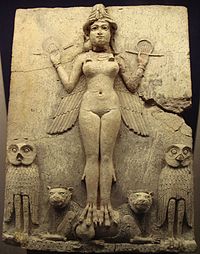
The Ancient Mesopotamian religion was the first recorded. Mesopotamians believed that the world was a flat disc,[45] surrounded by a huge, holed space, and above that, heaven. They believed that water was everywhere, the top, bottom and sides, and that the universe was born from this enormous sea. Mesopotamian religion was polytheistic. Although the beliefs described above were held in common among Mesopotamians, there were regional variations. The Sumerian word for universe is an-ki, which refers to the god An and the goddess Ki.[46] Their son was Enlil, the air god. They believed that Enlil was the most powerful god. He was the chief god of the pantheon.
Philosophy
The numerous civilizations of the area influenced the Abrahamic religions, especially the Hebrew Bible. Its cultural values and literary influence are especially evident in the Book of Genesis.[47]
Giorgio Buccellati believes that the origins of philosophy can be traced back to early Mesopotamian wisdom, which embodied certain philosophies of life, particularly ethics, in the forms of dialectic, dialogues, epic poetry, folklore, hymns, lyrics, prose works, and proverbs. Babylonian reason and rationality developed beyond empirical observation.[48]
Babylonian thought was also based on an open-systems ontology which is compatible with ergodic axioms.[49] Logic was employed to some extent in Babylonian astronomy and medicine.
Babylonian thought had a considerable influence on early Ancient Greek and Hellenistic philosophy. In particular, the Babylonian text Dialogue of Pessimism contains similarities to the agonistic thought of the Sophists, the Heraclitean doctrine of dialectic, and the dialogs of Plato, as well as a precursor to the Socratic method.[50] The Ionian philosopher Thales was influenced by Babylonian cosmological ideas.
Culture

Festivals
Ancient Mesopotamians had ceremonies each month. The theme of the rituals and festivals for each month was determined by at least six important factors:
- The Lunar phase (a waxing moon meant abundance and growth, while a waning moon was associated with decline, conservation, and festivals of the Underworld)
- The phase of the annual agricultural cycle
- Equinoxes and solstices
- The local mythos and its divine Patrons
- The success of the reigning Monarch
- The Akitu, or New Year Festival (first full moon after spring equinox)
- Commemoration of specific historical events (founding, military victories, temple holidays, etc.)
Music

Some songs were written for the gods but many were written to describe important events. Although music and songs amused kings, they were also enjoyed by ordinary people who liked to sing and dance in their homes or in the marketplaces.
Songs were sung to children who passed them on to their children. Thus songs were passed on through many generations as an oral tradition until writing was more universal. These songs provided a means of passing on through the centuries highly important information about historical events.
Games

Hunting was popular among Assyrian kings. Boxing and wrestling feature frequently in art, and some form of polo was probably popular, with men sitting on the shoulders of other men rather than on horses.[53]
They also played a board game similar to senet and backgammon, now known as the "Royal Game of Ur".
Family life

Mesopotamia, as shown by successive law codes, those of Urukagina, Lipit Ishtar and Hammurabi, across its history became more and more a patriarchal society, one in which the men were far more powerful than the women. For example, during the earliest Sumerian period, the "en", or high priest of male gods was originally a woman, that of female goddesses. Thorkild Jacobsen, as well as others, have suggested that early Mesopotamian society was ruled by a "council of elders" in which men and women were equally represented, but that over time, as the status of women fell, that of men increased.[54]
As for schooling, only royal offspring and sons of the rich and professionals, such as scribes, physicians, temple administrators, went to school. Most boys were taught their father's trade or were apprenticed out to learn a trade.[55] Girls had to stay home with their mothers to learn housekeeping and cooking, and to look after the younger children. Some children would help with crushing grain or cleaning birds. Unusually for that time in history, women in Mesopotamia had rights. They could own property and, if they had good reason, get a divorce.[56]: 78–79
Burials
Hundreds of graves have been excavated in parts of Mesopotamia, revealing information about Mesopotamian burial habits. In the city of Ur, most people were buried in family graves under their houses, along with some possessions. A few have been found wrapped in mats and carpets. Deceased children were put in big "jars" which were placed in the family chapel. Other remains have been found buried in common city graveyards. 17 graves have been found with very precious objects in them. It is assumed that these were royal graves. Rich of various periods, have been discovered to have sought burial in Bahrein, identified with Sumerian Dilmun.[57]
Economy

Sumerian temples functioned as banks and developed the first large-scale system of loans and credit. The Babylonians developed the earliest system of commercial banking. It was comparable in some ways to modern post-Keynesian economics, but with a more "anything goes" approach.[49]
Agriculture
Irrigated agriculture spread southwards from the Zagros foothills with the Samara and Hadji Muhammed culture, from about 5,000 BC.[58]
In the early period down to Ur III temples owned up to one third of the available land, declining over time as royal and other private holdings increased in frequency. The word Ensi was used to describe the official who organized the work of all facets of temple agriculture. Villeins are known to have worked most frequently within agriculture, especially in the grounds of temples or palaces.[59]
The geography of southern Mesopotamia is such that agriculture is possible only with irrigation and with good drainage, a fact which had a profound effect on the evolution of early Mesopotamian civilization. The need for irrigation led the Sumerians, and later the Akkadians, to build their cities along the Tigris and Euphrates and the branches of these rivers. Major cities, such as Ur and Uruk, took root on tributaries of the Euphrates, while others, notably Lagash, were built on branches of the Tigris. The rivers provided the further benefits of fish, used both for food and fertilizer, reeds, and clay, for building materials. With irrigation, the food supply in Mesopotamia was comparable to that of the Canadian prairies.[60]
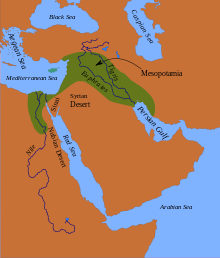
The Tigris and Euphrates River valleys form the northeastern portion of the Fertile Crescent, which also included the Jordan River valley and that of the Nile. Although land nearer to the rivers was fertile and good for crops, portions of land farther from the water were dry and largely uninhabitable. Thus the development of irrigation became very important for settlers of Mesopotamia. Other Mesopotamian innovations include the control of water by dams and the use of aqueducts. Early settlers of fertile land in Mesopotamia used wooden plows to soften the soil before planting crops such as barley, onions, grapes, turnips, and apples.
Mesopotamian settlers were some of the first people to make beer and wine. As a result of the skill involved in farming in the Mesopotamian region, farmers did not generally depend on slaves to complete farm work for them, but there were some exceptions. There were too many risks involved to make slavery practical, i.e. the escape/mutiny of the slaves. Although the rivers sustained life, they also destroyed it by frequent floods that ravaged entire cities. The unpredictable Mesopotamian weather was often hard on farmers. Crops were often ruined, so backup sources of food such as cows and lambs were kept. Over time the southernmost parts of Sumerian Mesopotamia suffered from increased salinity of the soils, leading to a slow urban decline and a centring of power in Akkad, further north.
Trade
Mesopotamian trade with the Indus Valley civilisation flourished as early as the third millennium BC.[61] Cylinder seals found throughout ANE is evidence of trade between Mesopotamian cities.[62] Starting in the 4th millennium BC, Mesopotamian civilizations also traded with ancient Egypt (see Egypt–Mesopotamia relations).[63][64]
For much of history, Mesopotamia served as a trade nexus – east-west between Central Asia and the Mediterranean world[65] (part of the Silk Road), as well as north–south between the Eastern Europe and Baghdad (Volga trade route). Vasco da Gama's pioneering (1497–1499) of the sea route between India and Europe and the opening of the Suez Canal in 1869 impacted on this nexus.[66][67]
Genetics
Genetic studies on the modern day people of Iraq are limited and generally restricted to analysis of classical keys due to the country's modern political instability,[68] although lately, there have been several published studies displaying a genealogical connection between all Iraqis and the neighboring countries, across religious, ethnic and linguistic barriers. Studies indicate that the different ethno-religious groups of Iraq (Mesopotamia) share significant similarities in genetics and that Mesopotamian Arabs, who make up the majority of Iraqis, are more genetically similar to Iraqi Kurds than other Arab populations in the Middle East and Arabia.[69]
There were no significant differences in Y-DNA variation were observed among Iraqi Mesopotamian Arabs, Assyrians, or Kurds.[68] Modern genetic studies indicate that Iraqi Mesopotamian Arabs are more related to Iraqi-Assyrians than Iraqi Kurds.[70][71]
Dogan et. al (2017) states that contemporary Assyrian and Yazidis from northern Iraq might "have stronger continuity with the original genetic stock of the Mesopotamian people, which possibly provided the basis for the ethnogenesis of various subsequent Near Eastern populations." Among northern Iraqi Assyrians, J and R subclades were observed at 36% and 41% respectively, where R1a, R1b, J1 and J2 sub-clades accounted for 11%, 30%, 12% and 24%. For Yazidis, R haplogroup subclades dominate, where R1a and R1b account for 9% and 21%, respectively. The high prevalence of R and J macrohaplogroups is attributed to pre-Last Glacial Maximum events in the Near East.[72]
Many historians and anthropologists provide strong circumstantial evidence to presuppose that Iraq's Marsh Arabs share very strong links to the ancient Sumerians.[73][74]
While other studies indicate that the Iraqi-Assyrian population was found to be significantly related to other Iraqis, especially Mesopotamian Arabs,[75][73] likely due to the assimilation of indigenous Assyrians with other people groups who occupied and settled Mesopotamia after the fall of the Neo-Babylonian Empire.[76]
Government
The geography of Mesopotamia had a profound impact on the political development of the region. Among the rivers and streams, the Sumerian people built the first cities, along with irrigation canals which were separated by vast stretches of open desert or swamp where nomadic tribes roamed. Communication among the isolated cities was difficult and, at times, dangerous. Thus, each Sumerian city became a city-state, independent of the others and protective of its independence.
At times, one city would try to conquer and unify the region, but such efforts were resisted and failed for centuries. As a result, the political history of Sumer is one of almost constant warfare. Eventually Sumer was unified by Eannatum. The unification was tenuous and failed to last, as the Akkadians conquered Sumer in 2331 BC only a generation later. The Akkadian Empire was the first successful empire to last beyond a generation and see a peaceful succession of kings. The empire was relatively short-lived, as the Babylonians conquered them within only a few generations.
Kings
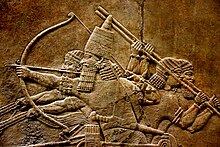
The Mesopotamians believed their kings and queens were descended from the city gods, but, unlike the ancient Egyptians, they never believed their kings were real gods.[77] Most kings named themselves "king of the universe" or "great king". Another common name was "shepherd", as kings had to look after their people.
Power
When Assyria grew into an empire, it was divided into smaller parts, called provinces. Each of these were named after their main cities, like Nineveh, Samaria, Damascus, and Arpad. They all had their own governor, who had to make sure everyone paid their taxes. Governors had to call up soldiers to war and supply workers when a temple was built. He was responsible for enforcing the laws. In this way, it was easier to keep control of a large empire.
Although Babylon was quite a small state in Sumer, it grew tremendously throughout the time of Hammurabi's rule. He was known as "the lawmaker" and created the Code of Hammurabi. Soon Babylon became one of the main cities in Mesopotamia. It was later called Babylonia, which meant "the gateway of the gods." It became one of history's greatest centers of learning.
Warfare
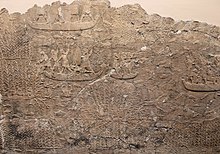
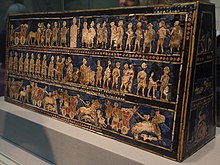
With the end of the Uruk phase, walled cities grew. Many isolated Ubaid villages were abandoned, indicating a rise in communal violence. An early king Lugalbanda was supposed to have built the white walls around the city. As city-states began to grow, their spheres of influence overlapped, creating arguments between other city-states, especially over land and canals. These arguments were recorded in tablets several hundreds of years before any major war—the first recording of a war occurred around 3200 BC, but was not common until about 2500 BC.[78]
An Early Dynastic II king (Ensi) of Uruk in Sumer, Gilgamesh (c. 2600 BC), was commended for military exploits against Humbaba guardian of the Cedar Mountain, and was later celebrated in many later poems and songs in which he was claimed to be two-thirds god and only one-third human. The later Stele of the Vultures at the end of the Early Dynastic III period (2600–2350 BC), commemorating the victory of Eannatum of Lagash over the neighbouring rival city of Umma, is the oldest monument in the world that celebrates a massacre.[79]
From this point forwards, warfare was incorporated into the Mesopotamian political system. At times, a neutral city acted as an arbitrator for two rival cities. This helped to form unions between cities, leading to regional states.[77] When empires were created, they went to war more with foreign countries. King Sargon, for example, conquered all the cities of Sumer, some cities in Mari, and then went to war with cities in modern-day Syria. Many Assyrian and Babylonian palace walls were decorated with pictures of the successful fights and the enemy either desperately escaping or hiding amongst reeds.
The Neo-Babylonian kings used deportation as a means of control, like their predecessors, the Assyrians. For the Neo-Babylonian kings, war was a means to obtain tribute, plunder, sought after materials such as various metals and quality wood, and prisoners of war which could be put to work as slaves in the temples which they built. The Assyrians displaced populations throughout their vast empire. This practice under the Babylonian kings was more limited, only being used to establish new populations in Babylonia itself. Though royal inscriptions from the Neo-Babylonian period don't speak of acts of destruction and deportation in the same boastful way royal inscriptions from the Neo-Assyrian period do, this does not prove that the practice ceased, or that the Babylonians were less brutal than the Assyrians, since there is evidence that the city Ascalon was destroyed by Nebuchadnezzar II in 604 BC.[80][81]
Laws
City-states of Mesopotamia created the first law codes, drawn from legal precedence and decisions made by kings. The codes of Urukagina and Lipit-Ishtar (the Code of Lipit-Ishtar) have been found. The most renowned of these was that of Hammurabi, as mentioned above, who was posthumously famous for his set of laws, the Code of Hammurabi, created c. 1780 BC, which is one of the earliest sets of laws found and one of the best preserved examples of this type of document from ancient Mesopotamia. He codified over 200 laws for Mesopotamia. Examination of the laws show a progressive weakening of the rights of women, and increasing severity in the treatment of slaves.[82]
Art
The art of Mesopotamia rivalled that of Ancient Egypt as the most grand, sophisticated and elaborate in western Eurasia, from the 4th millennium BC until the Persian Achaemenid Empire conquered the region in the 6th century BC. The main emphasis was on very durable, forms of sculpture in stone and clay. Little painting has survived, but what has suggests that painting was mainly used for geometrical and plant-based decorative schemes. Most sculpture was also painted.
The Protoliterate period, dominated by Uruk, saw the production of sophisticated works like the Warka Vase and cylinder seals. The Guennol Lioness is an outstanding small limestone figure from Elam of about 3000–2800 BC, part man and part lion.[83] A little later there are a number of figures of large-eyed priests and worshippers, mostly in alabaster and up to a foot high, who attended temple cult images of the deity, but very few of these have survived.[84] Sculptures from the Sumerian and Akkadian period generally had large, staring eyes, and long beards on the men. Many masterpieces have been found at the Royal Cemetery at Ur (c. 2650 BC), including the two figures of a Ram in a Thicket, the Copper Bull and a bull's head on one of the Lyres of Ur.[85]
From the many subsequent periods before the ascendency of the Neo-Assyrian Empire, Mesopotamian art survives in a number of forms: cylinder seals, relatively small figures in the round, and reliefs of various sizes, including cheap plaques of moulded pottery for the home, some religious and some apparently not.[86] The Burney Relief is an unusual elaborate and relatively large (20 x 15 inches) terracotta plaque of a naked winged goddess with the feet of a bird of prey, and attendant owls and lions. It comes from the 18th or 19th century BC, and may also be moulded.[87]
Stone stelae, votive offerings, or ones probably commemorating victories and showing feasts, are found from temples, which unlike more official ones lack inscriptions that would explain them.[88] The fragmentary Stele of the Vultures is an early example of the inscribed type.[89] The Assyrian Black Obelisk of Shalmaneser III a large and solid late one.[90]
The conquest of the whole of Mesopotamia and much surrounding territory by the Assyrians created a larger and wealthier state than the region had known before, and very grandiose art in palaces and public places, no doubt partly intended to match the splendour of the art of the neighbouring Egyptian empire. The Assyrians developed a style of extremely large schemes of very finely detailed narrative low reliefs in stone for palaces, with scenes of war or hunting. The British Museum has an outstanding collection. They produced very little sculpture in the round, except for colossal guardian figures, often the human-headed lamassu, which are sculpted in high relief on two sides of a rectangular block, with the heads effectively in the round, and five legs, so that both views seem complete. Even before dominating the region, they continued the cylinder seal tradition, with designs which are often exceptionally energetic and refined.[91]
-
Bronze head of an Akkadian ruler, discovered in Nineveh in 1931, presumably depicting either Sargon of Akkad or Sargon's grandson Naram-Sin.[92]
-
Striding lions from the Processional Street of Babylon.
-
Assyrian ornaments and patterns, illustrated in a book from 1920
-
Detail of Nebuchadnezzar II's Building Inscription plaque of the Ishtar Gate, from Babylon
-
Artist's impression of a hall in an Assyrian palace from The Monuments of Nineveh by Austen Henry Layard, 1853
-
A Neo-Assyrian relief of Ashur as a feather robed archer holding a bow instead of a ring (9th-8th century BC)
-
The Black Obelisk of Shalmaneser III. The king, surrounded by his royal attendants and a high-ranking official, receives a tribute from Sua, king of Gilzanu (north-west Iran), who bows and prostrates before the king. From Nimrud
-
"Winged genie", Nimrud c. 870 BC, with inscription running across his midriff.
Architecture
The study of ancient Mesopotamian architecture is based on available archaeological evidence, pictorial representation of buildings, and texts on building practices. Scholarly literature usually concentrates on temples, palaces, city walls and gates, and other monumental buildings, but occasionally one finds works on residential architecture as well.[95] Archaeological surface surveys also allowed for the study of urban form in early Mesopotamian cities.
Brick is the dominant material, as the material was freely available locally, whereas building stone had to be brought a considerable distance to most cities.[96] The ziggurat is the most distinctive form, and cities often had large gateways, of which the Ishtar Gate from Neo-Babylonian Babylon, decorated with beasts in polychrome brick, is the most famous, now largely in the Pergamon Museum in Berlin.
The most notable architectural remains from early Mesopotamia are the temple complexes at Uruk from the 4th millennium BC, temples and palaces from the Early Dynastic period sites in the Diyala River valley such as Khafajah and Tell Asmar, the Third Dynasty of Ur remains at Nippur (Sanctuary of Enlil) and Ur (Sanctuary of Nanna), Middle Bronze Age remains at Syrian-Turkish sites of Ebla, Mari, Alalakh, Aleppo and Kultepe, Late Bronze Age palaces at Hattusa, Ugarit, Ashur and Nuzi.
Iron Age palaces and temples are found at the Assyrian (Kalhu/Nimrud, Khorsabad, Nineveh), Babylonian (Babylon), Urartian (Tushpa/Van, Kalesi, Cavustepe, Ayanis, Armavir, Erebuni, Bastam) and Neo-Hittite sites (Karkamis, Tell Halaf, Karatepe). Houses are mostly known from Old Babylonian remains at Nippur and Ur. Among the textual sources on building construction and associated rituals, are Gudea's cylinders from the late 3rd millennium, as well as the Assyrian and Babylonian royal inscriptions from the Iron Age.
-
The Ishtar gate was constructed in about 575 BC by order of King Nebuchadnezzar II. Pergamon Museum, Berlin
-
The walls of Babylon, in Babylon
-
The Ziggurat of Ur
-
The ziggurat of Dur-kuriagalzu in 2010
-
A suggested reconstruction of the appearance of a Sumerian ziggurat
References
Notes
- ^ Turkish: Mezopotamya; Ancient Greek: Μεσοποταμία Mesopotamíā; Arabic: بِلَاد ٱلرَّافِدَيْن Bilād ar-Rāfidayn or بَيْنُ ٱلْنَهْرَيْن Bayn ul-Nahrayn; Persian: میانرودان miyân rudân; Classical Syriac: ܒܝܬ ܢܗܪ̈ܝܢ, Bēṯ Nahrēn
Citations
- ^ Seymour, Michael (2004). "Ancient Mesopotamia and Modern Iraq in the British Press, 1980–2003". Current Anthropology. 45 (3): 351–368. doi:10.1086/383004. ISSN 0011-3204. JSTOR 10.1086/383004. S2CID 224788984. Archived from the original on 30 April 2022. Retrieved 30 April 2022.
- ^ a b c Miquel, A.; Brice, W. C.; Sourdel, D.; Aubin, J.; Holt, P. M.; Kelidar, A.; Blanc, H.; MacKenzie, D. N.; Pellat, Ch. (2011), "ʿIrāḳ", in Bearman, P.; Bianquis, Th.; Bosworth, C. E.; van Donzel, E.; Heinrichs, W. P. (eds.), Encyclopaedia of Islam, Second Edition, Leiden, Netherlands: Brill Online, OCLC 624382576.
- ^ Sissakian, Varoujan K.; Adamo, Nasrat; Al-Ansari, Nadhir; Mukhalad, Talal; Laue, Jan (January 2020). "Sea Level Changes in the Mesopotamian Plain and Limits of the Arabian Gulf: A Critical Review". Journal of Earth Sciences and Geotechnical Engineering. 10 (4): 88–110.
- ^ Pollock, Susan (1999), Ancient Mesopotamia. The Eden that never was, Case Studies in Early Societies, Cambridge: Cambridge University Press, p. 1, ISBN 978-0-521-57568-3
- ^ Milton-Edwards, Beverley (May 2003). "Iraq, past, present and future: a thoroughly-modern mandate?". History & Policy. United Kingdom. Archived from the original on 8 December 2010. Retrieved 9 December 2010.
- ^ Lemche, Niels Peter (2004). "Assyria and Babylonia". Historical dictionary of ancient Israel. Historical dictionaries of ancient civilizations and historical eras. Lanham, Md.: Scarecrow Press. pp. 64–67. ISBN 978-0-8108-4848-1.
- ^ Hogg, Hope Waddell (1911). . In Chisholm, Hugh (ed.). Encyclopædia Britannica. Vol. 18 (11th ed.). Cambridge University Press. pp. 179–187.
- ^ Finkelstein, J. J. (1962), "Mesopotamia", Journal of Near Eastern Studies, 21 (2): 73–92, doi:10.1086/371676, JSTOR 543884, S2CID 222432558.
- ^ a b Foster, Benjamin R.; Polinger Foster, Karen (2009), Civilizations of ancient Iraq, Princeton: Princeton University Press, ISBN 978-0-691-13722-3
- ^ a b Canard, M. (2011), "al-ḎJazīra, Ḏjazīrat Aḳūr or Iḳlīm Aḳūr", in Bearman, P.; Bianquis, Th.; Bosworth, C. E.; van Donzel, E.; Heinrichs, W. P. (eds.), Encyclopaedia of Islam, Second Edition, Leiden, Netherlands: Brill Online, OCLC 624382576.
- ^ Wilkinson, Tony J. (2000), "Regional approaches to Mesopotamian archaeology: the contribution of archaeological surveys", Journal of Archaeological Research, 8 (3): 219–267, doi:10.1023/A:1009487620969, ISSN 1573-7756, S2CID 140771958.
- ^ Matthews, Roger (2003), The archaeology of Mesopotamia. Theories and approaches, Approaching the past, Milton Square: Routledge, ISBN 978-0-415-25317-8.
- ^ a b Bahrani, Z. (1998), "Conjuring Mesopotamia: imaginative geography and a world past", in Meskell, L. (ed.), Archaeology under fire: Nationalism, politics and heritage in the Eastern Mediterranean and Middle East, London, England: Routledge, pp. 159–174, ISBN 978-0-415-19655-0.
- ^ Scheffler, Thomas (2003). "'Fertile crescent', 'Orient', 'Middle East': the changing mental maps of Southeast Asia". European Review of History. 10 (2): 253–272. doi:10.1080/1350748032000140796. S2CID 6707201.
- ^ Broadbent, G., "The Ecology of the Mudhif", in: Geoffrey Broadbent and C. A. Brebbia, Eco-architecture II: Harmonisation Between Architecture and Nature, WIT Press, 2008, pp. 15–26.
- ^ Emberling 2015, p. 255.
- ^ Emberling 2015, p. 256.
- ^ Thompson, William R. (2004) "Complexity, Diminishing Marginal Returns, and Serial Mesopotamian Fragmentation", (Vol 3, Journal of World-Systems Research).
- ^ "Migrants from the Near East 'brought farming to Europe'". BBC. 10 November 2010. Archived from the original on 13 December 2010. Retrieved 10 December 2010.
- ^ Pollock, Susan (1999), Ancient Mesopotamia. The Eden that never was, Case Studies in Early Societies, Cambridge: Cambridge University Press, p. 2, ISBN 978-0-521-57568-3.
- ^ "Ancient History in depth: Mesopotamia". BBC History. Archived from the original on 28 June 2017. Retrieved 21 July 2017.
- ^ Finkelstein, J. J. (1955). "Subartu and Subarian in Old Babylonian Sources". Journal of Cuneiform Studies. 9 (1): 1–7. doi:10.2307/1359052. JSTOR 1359052. S2CID 163484083.
- ^ Guo, Rongxing (2017). An Economic Inquiry into the Nonlinear Behaviors of Nations: Dynamic Developments and the Origins of Civilizations. Palgrave Macmillan. p. 23. ISBN 9783319487724. Archived from the original on 14 April 2021. Retrieved 8 July 2019.
It was not until the widespread use of a syllabic script was adopted under Sargon's rule that significant portions of Sumerian population became literate.
- ^ Woods C. (2006). "Bilingualism, Scribal Learning, and the Death of Sumerian". In S. L. Sanders (ed) Margins of Writing, Origins of Culture: 91–120, Chicago, Illinois [1]. Archived 29 April 2013 at the Wayback Machine.
- ^ Tetlow, Elisabeth Meier (28 December 2004). Women, Crime and Punishment in Ancient Law and Society: Volume 1: The Ancient Near East. A&C Black. p. 75. ISBN 9780826416285. Archived from the original on 22 May 2020. Retrieved 20 June 2015.
- ^ Eves, Howard (1969). An Introduction to the History of Mathematics. Holt, Rinehart and Winston. p. 31. ISBN 9780030745508.
- ^ Eves, Howard (1969). An Introduction to the History of Mathematics. Holt, Rinehart and Winston. p. 31. ISBN 9780030745508.
- ^ Struik, Dirk J. (1987). A Concise History of Mathematics. New York: Dover Publications. ISBN 978-0-486-60255-4.
- ^ Fowler and Robson, p. 368. Photograph, illustration, and description of the root(2) tablet from the Yale Babylonian Collection. Archived 2012-08-13 at the Wayback Machine. High resolution photographs, descriptions, and analysis of the root(2) tablet (YBC 7289) from the Yale Babylonian Collection. Archived 12 July 2020 at the Wayback Machine.
- ^ Boyer 1991, "Mesopotamia" p. 30: "Babylonian mathematicians did not hesitate to interpolate by proportional parts to approximate intermediate values. Linear interpolation seems to have been a commonplace procedure in ancient Mesopotamia, and the positional notation lent itself conveniently to the rile of three. [...] a table essential in Babylonian algebra; this subject reached a considerably higher level in Mesopotamia than in Egypt. Many problem texts from the Old Babylonian period show that the solution of the complete three-term quadratic equation afforded the Babylonians no serious difficulty, for flexible algebraic operations had been developed. They could transpose terms in an equations by adding equals to equals, and they could multiply both sides by like quantities to remove fractions or to eliminate factors. By adding to they could obtain for they were familiar with many simple forms of factoring. [...]Egyptian algebra had been much concerned with linear equations, but the Babylonians evidently found these too elementary for much attention. [...] In another problem in an Old Babylonian text we find two simultaneous linear equations in two unknown quantities, called respectively the "first silver ring" and the "second silver ring.""
- ^ Joyce, David E. (1995). "Plimpton 322". Archived from the original on 8 March 2011. Retrieved 3 June 2022.
The clay tablet with the catalog number 322 in the G. A. Plimpton Collection at Columbia University may be the most well known mathematical tablet, certainly the most photographed one, but it deserves even greater renown. It was scribed in the Old Babylonian period between −1900 and −1600 and shows the most advanced mathematics before the development of Greek mathematics.
- ^ D. Brown (2000), Mesopotamian Planetary Astronomy-Astrology, Styx Publications, ISBN 90-5693-036-2.
- ^ Otto E. Neugebauer (1945). "The History of Ancient Astronomy Problems and Methods", Journal of Near Eastern Studies 4 (1), pp. 1–38.
- ^ George Sarton (1955). "Chaldaean Astronomy of the Last Three Centuries B.C.", Journal of the American Oriental Society 75 (3), pp. 166–173 [169].
- ^ William P. D. Wightman (1951, 1953), The Growth of Scientific Ideas, Yale University Press, p. 38.
- ^ Pingree (1998).
- ^ a b H. F. J. Horstmanshoff, Marten Stol, Cornelis Tilburg (2004), Magic and Rationality in Ancient Near Eastern and Graeco-Roman Medicine, p. 99, Brill Publishers, ISBN 90-04-13666-5.
- ^ Stol 1993, p. 55.
- ^ Friedenwald, Julius; Morrison, Samuel (January 1940). "The History of the Enema with Some Notes on Related Procedures (Part I)". Bulletin of the History of Medicine. 8 (1). Johns Hopkins University Press: 77. JSTOR 44442727.
- ^ H. F. J. Horstmanshoff, Marten Stol, Cornelis Tilburg (2004), Magic and Rationality in Ancient Near Eastern and Graeco-Roman Medicine, pp. 97–98, Brill Publishers, ISBN 90-04-13666-5.
- ^ Stol 1993, p. 5.
- ^ Teall, Emily (October 2014). "Medicine and Doctoring in Ancient Mesopotamia". Grand Valley Journal of History. 3 (1): 3.
- ^ Stephanie Dalley and John Peter Oleson (January 2003). "Sennacherib, Archimedes, and the Water Screw: The Context of Invention in the Ancient World", Technology and Culture 44 (1).
- ^ Twist, Jo (20 November 2005), "Open media to connect communities", BBC News, archived from the original on 17 May 2019, retrieved 6 August 2007.
- ^ Lambert, W. G. (2016). Ancient Mesopotamian Religion and Mythology: Selected Essays. The Cosmology of Sumer & Babylon. Mohr Siebeck. p. 111. ISBN 978-3161536748. Archived from the original on 1 May 2022. Retrieved 8 July 2019.
- ^ Hetherington, Norriss S. (2014). Encyclopedia of Cosmology (Routledge Revivals) : Historical, Philosophical, and Scientific Foundations of Modern Cosmology. Hoboken: Taylor and Francis. p. 399. ISBN 9781317677666.
- ^ Bertman, Stephen (2005). Handbook to life in ancient Mesopotamia (Paperback ed.). Oxford [u.a.], England: Oxford University Press. p. 312. ISBN 978-0-19-518364-1.
- ^ Giorgio Buccellati (1981), "Wisdom and Not: The Case of Mesopotamia", Journal of the American Oriental Society 101 (1), pp. 35–47.
- ^ a b Dow, Sheila C. (April 2005). "Axioms and Babylonian thought: A reply". Journal of Post Keynesian Economics. 27 (3): 385–391. doi:10.1080/01603477.2005.11051453. S2CID 153637070. Archived from the original on 3 August 2020. Retrieved 7 December 2019.
- ^ Giorgio Buccellati (1981), "Wisdom and Not: The Case of Mesopotamia", Journal of the American Oriental Society 101 (1), pp. 35–47 43.
- ^ Black & Green 1992, pp. 156, 169–170.
- ^ Liungman 2004, p. 228.
- ^ Nemet-Nejat, Karen Rhea (1998), Daily Life in Ancient Mesopotamia.
- ^ Harris, Rivkah (2000), Gender and Aging in Mesopotamia.
- ^ Harris, Rivkah (2000), Gender and Aging in Mesopotamia.
- ^ Kramer, Samuel Noah (1963). The Sumerians: Their History, Culture, and Character. The University of Chicago Press. ISBN 978-0-226-45238-8.
- ^ Bibby, Geoffrey and Phillips, Carl (1996), "Looking for Dilmun" (Interlink Pub Group).
- ^ Bulliet, Richard; Crossley, Pamela Kyle; Headrick, Daniel; Hirsch, Steven; Johnson, Lyman; Northup, David (1 January 2010). The Earth and Its Peoples: A Global History. Cengage Learning. ISBN 978-0-538-74438-6. Archived from the original on 14 April 2021. Retrieved 30 May 2012.
- ^ Saggs, H. W. F. – Professor Emeritus of Semitic Languages at University College, Cardiff, Wales (2000). Babylonians. University of California Press. ISBN 978-0-520-20222-1. Archived from the original on 14 April 2021. Retrieved 29 May 2012.
{{cite book}}: CS1 maint: multiple names: authors list (link) - ^ Roux, Georges, (1993) "Ancient Iraq" (Penguin).
- ^ Wheeler, Mortimer (1953). The Indus Civilization. Cambridge history of India: Supplementary volume (3 ed.). Cambridge: Cambridge University Press (published 1968). p. 111. ISBN 9780521069588. Archived from the original on 10 April 2021. Retrieved 10 April 2021.
In calculating the significance of Indus contacts with Mesopotamia, it is obvious that the economic vitality of Mesopotamia is the controlling factor. Documentary evidence there vouches for vigorous commercial activity in the Sarginid and Larsa phases [...]
- ^ Wayne, Alexander; William, Violet (February 2012). "Trade and Traders of Mesopotamian Ur" (PDF). Journal of Business and Behavior Sciences. 19 (2012): 2.
- ^ Shaw, Ian. & Nicholson, Paul, The Dictionary of Ancient Egypt, (London: British Museum Press, 1995), p. 109.
- ^ Mitchell, Larkin. "Earliest Egyptian Glyphs". Archaeology. Archaeological Institute of America. Archived from the original on 27 December 2012. Retrieved 29 February 2012.
- ^ Bryce, James (1886). "The Relations of History and Geography". Littell's Living Age. 5. 169. Boston: Littell and Company: 70. Archived from the original on 11 April 2021. Retrieved 10 April 2021.
There was also an important trade route through central Asia, which coming down through Persia and Mesopotamia to the Levant, reached the sea in northern Syria [...]. These trade routes assumed enormous importance in the earlier Middle Ages, and upon them great political issues turned.
- ^ Bulliet, Richard; Crossley, Pamela Kyle; Headrick, Daniel R.; Hirsch, Steven W.; Johnson, Lyman L.; Northrup, David (2009). "Interregional Patterns of Culture and Contact". The Earth and Its Peoples: A Global History (6 ed.). Cengage Learning (published 2014). p. 279. ISBN 9781305147096. Archived from the original on 11 April 2021. Retrieved 10 April 2021.
Eurasia's overland trade faded, and merchants, soldiers, and explorers took to the seas.
- ^
Brebbia, Carlos A.; Martinez Boquera, A., eds. (28 December 2016). Islamic Heritage Architecture. Volume 159 of WIT transactions on the built environment. Southampton: WIT Press (published 2016). p. 111. ISBN 9781784662370. Retrieved 10 April 2021.
[...] the Silk Road [...] passed through central Asia and Mesopotamia. When the Suez Canal was inaugurated in 1869, trade was diverted to the sea [...].
- ^ a b Al-Zahery, N.; et al. (2003). ""Y-chromosome and mtDNA polymorphisms in Iraq, a crossroad of the early human dispersal and of post-Neolithic migrations"" (PDF). Archived from the original (PDF) on 27 December 2010. Retrieved 10 December 2010.
- ^ Lazim, Hayder; Almohammed, Eida Khalaf; Hadi, Sibte; Smith, Judith (2020). "Population genetic diversity in an Iraqi population and gene flow across the Arabian Peninsula". Nature. 10 (1): 15289. Bibcode:2020NatSR..1015289L. doi:10.1038/s41598-020-72283-1. PMC 7499422. PMID 32943725.
- ^ Luigi Luca Cavalli-Sforza, Paolo Menozzi, Alberto Piazza, The History and Geography of Human Genes, p. 242.
- ^ "Cavalli-Sforza et al. Genetic tree of West Asia". Archived from the original on 14 June 2011. Retrieved 10 December 2010.
- ^ Dogan, Serkan; Gurkan, Cemal; Dogan, Mustafa; et al. (2017). "A glimpse at the intricate mosaic of ethnicities from Mesopotamia: Paternal lineages of the Northern Iraqi Arabs, Kurds, Syriacs, Turkmens and Yazidis". PLOS ONE. 12 (11): e0187408. Bibcode:2017PLoSO..1287408D. doi:10.1371/journal.pone.0187408. PMC 5669434. PMID 29099847.
 This article incorporates text available under the CC BY 4.0 license.
This article incorporates text available under the CC BY 4.0 license.
- ^ a b Al-Zahery; et al. (October 2011). "In search of the genetic footprints of Sumerians: a survey of Y-chromosome and mtDNA variation in the Marsh Arabs of Iraq". BMC Evolutionary Biology. 11 (1): 288. Bibcode:2011BMCEE..11..288A. doi:10.1186/1471-2148-11-288. PMC 3215667. PMID 21970613.
- ^ Spencer, William (2000). Iraq: Old Land, New Nation in Conflict. Twenty-First Century Books. p. 17. ISBN 978-0-7613-1356-4.
- ^ Cavalli-Sforza; et al. "Genetic tree of West Asia". Archived from the original on 14 June 2011. Retrieved 10 December 2010.
- ^ Tubiana, Joseph (22 October 2012). "Siegbert Uhlig (ed.): Encyclopaedia Aethiopica. Volume 1". Aethiopica. 7: 194–211. doi:10.15460/aethiopica.7.1.294. ISSN 2194-4024.
- ^ a b Dalling, Robert (2004), The Story of Us Humans, from Atoms to Today's Civilization.
- ^ Winter, Irene J. (1985). "After the Battle is Over: The 'Stele of the Vultures' and the Beginning of Historical Narrative in the Art of the Ancient Near East". In Kessler, Herbert L.; Simpson, Marianna Shreve. Pictorial Narrative in Antiquity and the Middle Ages. Center for Advanced Study in the Visual Arts, Symposium Series IV. 16. Washington, D.C.: National Gallery of Art. pp. 11–32. ISSN 0091-7338.
- ^ Winter, Irene J. (1985). "After the Battle is Over: The 'Stele of the Vultures' and the Beginning of Historical Narrative in the Art of the Ancient Near East". In Kessler, Herbert L.; Simpson, Marianna Shreve. Pictorial Narrative in Antiquity and the Middle Ages. Center for Advanced Study in the Visual Arts, Symposium Series IV. 16. Washington, D.C.: National Gallery of Art. pp. 11–32. ISSN 0091-7338.
- ^ Beaulieu 2005, pp. 57–58.
- ^ Stager 1996, pp. 57–69, 76–77.
- ^ Fensham, F. Charles (19620, "Widow, Orphan, and the Poor in Ancient near Eastern Legal and Wisdom Literature" (Journal of Near Eastern Studies, Vol. 21, No. 2 (April 1962)), pp. 129–139.
- ^ Frankfort 1970, pp. 24–37.
- ^ Frankfort 1970, pp. 45–59.
- ^ Frankfort 1970, pp. 61–66.
- ^ Frankfort 1970, Chapters 2–5.
- ^ Frankfort 1970, pp. 110–112.
- ^ Frankfort 1970, pp. 66–74.
- ^ Frankfort 1970, pp. 71–73.
- ^ Frankfort 1970, pp. 66–74, 167.
- ^ Frankfort 1970, pp. 141–193.
- ^ M. E. L. Mallowan, "The Bronze Head of the Akkadian Period from Nineveh. Archived 21 April 2020 at the Wayback Machine", Iraq Vol. 3, No. 1 (1936), pp. 104–110.
- ^ Leick, Gwendolyn (2002). A Dictionary of Ancient Near Eastern Mythology. Routledge. pp. 109–110. ISBN 978-1-134-64102-4. Archived from the original on 21 November 2021. Retrieved 10 March 2022.
- ^ "Livius.org". Archived from the original on 1 June 2014. Retrieved 10 March 2022.
- ^ Dunham, Sally (2005), "Ancient Near Eastern architecture", in Snell, Daniel (ed.), A Companion to the Ancient Near East, Oxford, England: Blackwell, pp. 266–280, ISBN 978-0-631-23293-3.
- ^ "Mesopotamia". World History Encyclopedia. Archived from the original on 10 April 2021. Retrieved 21 July 2017.
Sources
- Beaulieu, P. A. (2005). "World Hegemony, 900–300 BCE". In Snell, D. C. (ed.). A Companion to the Ancient Near East. Oxford University Press. ISBN 978-1405160018.
- Black, Jeremy; Green, Anthony (1992). Gods, Demons and Symbols of Ancient Mesopotamia: An Illustrated Dictionary. The British Museum Press. ISBN 978-0-7141-1705-8.
- Boyer, Carl B. (1991). A History of Mathematics (2nd ed.). John Wiley & Sons. ISBN 978-0-471-54397-8.
- Emberling, Geoff (2015). "Mesopotamian cities and urban process, 3500–1600 BCE". In Yoffee, Norman (ed.). Early Cities in Comparative Perspective, 4000 BCE–1200 CE. The Cambridge World History. Vol. 3. Cambridge University Press. ISBN 978-0-521-19008-4.
- Frankfort, Henri (1970). The Art and Architecture of the Ancient Orient. Pelican History of Art (4th ed.). Penguin (now Yale History of Art). ISBN 0-14-056107-2.
- Liungman, Carl G. (2004). Symbols: Encyclopedia of Western Signs and Ideograms. Lidingö, Sweden: HME Publishing. ISBN 978-91-972705-0-2.
- Pingree, David (1998). "Legacies in Astronomy and Celestial Omens". In Dalley, Stephanie (ed.). The Legacy of Mesopotamia. Oxford University Press. pp. 125–137. ISBN 978-0-19-814946-0.
- Stager, L. E. (1996). "The fury of Babylon: Ashkelon and the archaeology of destruction". Biblical Archaeology Review. 22 (1).
- Stol, Marten (1993). Epilepsy in Babylonia. Brill Publishers. ISBN 90-72371-63-1.
Further reading
- Algaze, Guillermo, 2008 Ancient Mesopotamia at the Dawn of Civilization: the Evolution of an Urban Landscape. University of Chicago Press. ISBN 9780226013770.
- Atlas de la Mésopotamie et du Proche-Orient ancien, Brepols, 1996 ISBN 2-503-50046-3.
- Bottéro, Jean; 1987. (in French) Mésopotamie. L'écriture, la raison et les dieux, Gallimard, coll. « Folio Histoire », ISBN 2-07-040308-4.
- Bottéro, Jean (15 June 1995). Mesopotamia: Writing, Reasoning, and the Gods. Translated by Bahrani, Zainab; Van de Mieroop, Marc. University of Chicago Press. ISBN 978-0226067278.
- Edzard, Dietz Otto; 2004. Geschichte Mesopotamiens. Von den Sumerern bis zu Alexander dem Großen, München, Germany, ISBN 3-406-51664-5.
- Hrouda, Barthel and Rene Pfeilschifter; 2005. Mesopotamien. Die antiken Kulturen zwischen Euphrat und Tigris. München, Germany 2005 (4. Aufl.), ISBN 3-406-46530-7.
- Joannès, Francis (2001). Dictionnaire de la civilisation mésopotamienne, Robert Laffont.
- Korn, Wolfgang; 2004. Mesopotamien – Wiege der Zivilisation. 6000 Jahre Hochkulturen an Euphrat und Tigris, Stuttgart, Germany, ISBN 3-8062-1851-X.
- Matthews, Roger; 2005. The early prehistory of Mesopotamia – 500,000 to 4,500 BC, Turnhout 2005, ISBN 2-503-50729-8.
- Oppenheim, A. Leo; 1964. Ancient Mesopotamia: Portrait of a dead civilization. The University of Chicago Press: Chicago, Illinois and London, England. Revised edition completed by Erica Reiner, 1977.
- Pollock, Susan; 1999. Ancient Mesopotamia: the Eden that never was. Cambridge University Press: Cambridge.
- Postgate, J. Nicholas; 1992. Early Mesopotamia: Society and Economy at the dawn of history. Routledge: London, England and New York.
- Roux, Georges; 1964. Ancient Iraq, Penguin Books.
- Silver, Morris; 2007. Redistribution and Markets in the Economy of Ancient Mesopotamia: Updating Polanyi, Antiguo Oriente 5: 89–112.
- Williams, Henry Smith (Ed.) 1904, The historians' history of the world in twenty-five volumes, volume 01: Prolegomena; Egypt, Mesopotamia, Press of J. J. Little & Company. New York, U.S.A.
External links
- Ancient Mesopotamia – timeline, definition, and articles at World History Encyclopedia
- Mesopotamia – introduction to Mesopotamia from the British Museum
- By Nile and Tigris, a narrative of journeys in Egypt and Mesopotamia on behalf of the British museum between the years 1886 and 1913, by Sir E. A. Wallis Budge, 1920 (a searchable facsimile at the University of Georgia Libraries; DjVu & layered PDF format)
- Mesopotamian Archaeology. Archived 15 February 2005 at the Wayback Machine, by Percy S. P. Handcock, 1912 (a searchable facsimile at the University of Georgia Libraries; DjVu & "layered PDF format" (PDF). Archived from the original (PDF) on 7 October 2005. Retrieved 19 September 2005. (12.8 MB))




![Bronze head of an Akkadian ruler, discovered in Nineveh in 1931, presumably depicting either Sargon of Akkad or Sargon's grandson Naram-Sin.[92]](http://up.wiki.x.io/wikipedia/commons/thumb/2/24/Mask_of_Sargon_of_Akkad.jpg/120px-Mask_of_Sargon_of_Akkad.jpg)

![Lamassu, initially depicted as a goddess in Sumerian times, when it was called Lamma, it was later depicted from Assyrian times as a hybrid of a human, bird, and either a bull or lion—specifically having a human head, the body of a bull or a lion, and bird wings, under the name Lamassu.[93][94]](http://up.wiki.x.io/wikipedia/commons/thumb/1/18/Assyrian_Winged_Bull.jpg/90px-Assyrian_Winged_Bull.jpg)














